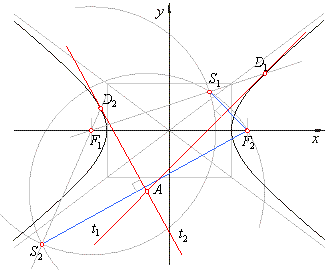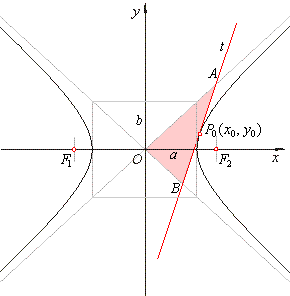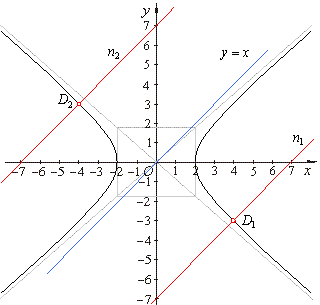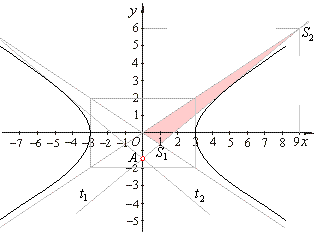|
| Conic
Sections |
|
|
|
|
Hyperbola
and Line
|
 Construction of tangents from a point outside the hyperbola
Construction of tangents from a point outside the hyperbola
|
 Properties of the hyperbola
Properties of the hyperbola
|
|
The area of a triangle which the tangent at a point on the hyperbola forms with
asymptotes |
 Hyperbola and line examples
Hyperbola and line examples
|
|
|
|
|
|
|
|
| Construction of tangents from a point outside the hyperbola |
|
With A as center draw an arc through
F2,
and from F1as center, draw an arc of radius
2a.
|
|
These arcs intersect at points
S1
and
S2.
|
|
Tangents are the
perpendicular bisectors of the line segments F2S1
and
F2S2.
|
|
Tangents can also be drawn as lines through
A and
the intersection points of lines through F1S1
and
F1S2,
with the hyperbola.
|
|
These intersections are at the same
time the points of contact
D1
and
D2.
|
|
 |
|
|
| Properties of the hyperbola
|
| -
The area of a triangle which the tangent at a point on the hyperbola forms with
asymptotes, is of constant
|
|
value A
= a ·
b. Vertices of the triangle are the origin
O
|
|
and the intersections
A and
B of the tangent to the
hyperbola at
the point P0(x0, y0)
with
asymptotes. Then,
|
|
(1) t1 ::
b2x0x
-
a2y0y
= a2b2
-the tangent
|
|
(2) y =
±
(b/a) · x
-asymptotes
|
the solution of the system of the equations
(1)
and (2)
gives intersections A and
B. Plugging
(2) into
(1)
|

|

|
|
 |
|
| Since one vertex of the triangle is the origin
O(0, 0) then
the formula for the area, AD=
(x2y1
-
x1y2)/2
or |
 |
|
| Hyperbola and line examples
|
| Example:
Determine the semi-axis
a
such that the line
5x
-
4y
-
16 = 0 be the tangent of the hyperbola |
| 9x2
-
a2y2 = 9a2. |
|
Solution:
Rewrite the equation
9x2
-
a2y2 = 9a2
| ¸
9a2
|
|
|
| and the equation of the tangent
5x
-
4y
-
16 = 0
or |
 |
|
| Then,
plug the slope and the intercept into tangency condition,
|
 |
| Therefore,
the given line is the tangent of the hyperbola |
 |
|
|
| Example:
The line 13x
-
15y
-
25 = 0 is the tangent of a hyperbola with linear eccentricity (half the focal
distance) cH =
Ö41.
Write the equation of the hyperbola.
|
| Solution:
Rewrite the equation 13x
-
15y
-
25 = 0
or |
 |
|
| Using
the linear eccentricity |
 |
|
| and
the tangency condition |
 |
| Thus,
the equation of the hyperbola, |
 |
|
|
| Example:
Find the normal to the hyperbola
3x2
-
4y2 = 12 which is parallel to the line
-x +
y = 0.
|
|
Solution:
Rewrite the equation of the hyperbola
|
|
3x2
-
4y2 = 12
| ¸12
|

|
|
The slope of the normal is equal to the slope of
the given line,
|
|
y =
x
=>
m
= 1,
mt =
-1/mn,
so mt =
-1
|
|
applying the tangency condition
|
|
a2m2
-
b2 = c2
<= mt =
-1,
a2 =
4 and
b2 = 3
|
|
4·(-1)2
-
3 = c2
=> c1,2 = ±1
|
|
tangents, t1
::
y =
-x
+ 1 and
t2
::
y =
-x
-
1.
|
|
The points of
tangency,
|
|
 |
|

|
| The
equations of the normals, |
| D1(4,
-3)
and m =
1
=>
y -
y1 = m ·(x
-x1),
y +
3 = 1·(x
- 4)
or n1
::
y = x -
7, |
| D2(-4,
3)
and m =
1 =>
y -
y1 = m ·(x
-x1),
y -
3 = 1·(x
+ 4)
or n2
::
y =
x + 7, |
|
| Example:
From the point A(0,
-3/2)
drawn are tangents to the hyperbola 4x2
-
9y2 = 36, find the
equations of the tangents and the area of the triangle which both tangents form with asymptotes. |
|
Solution:
Axes of the hyperbola we read from the standard form of equation,
|
|
4x2
-
9y2 = 36
| ¸36
|

|
|
We find tangents by solving the system of
equations,
|
|
(1) y =
mx + c
<=
A(0,
-3/2)
|
|
(2) a2m2
-
b2 = c2
<=
(1) c
= -3/2
|
|
|
|
9m2
-
4 = (-3/2)2,
9m2 =
25/4,
m1,2 =
±5/6
|
|
 |
|
| thus,
the equations of the tangents, |
| t1
::
y =
5/6x
-
3/2 or 5x
-
6y -
9 = 0 and
t2
::
y =
-5/6x
-
3/2 or 5x
+ 6y + 9 = 0. |
| The area of the triangle that tangents form with asymptotes we calculate
using the formula, |
| AD=
(x2y1
-
x1y2)/2,
where S1(x1,
y1) and S2(x2,
y2)
are the intersections (third vertex is the origin (0, 0)). |
| By solving system of
equations, |
 |
| Therefore,
the intersections S1(1,
-3/2)
and
S2(9,
6). |
| Then,
the area of the triangle AD=
(x2y1
-
x1y2)
/ 2
gives AD=
[1·6
-
9·(-2/3)]
= 6 square units. |
We can
get the same result using the property that the area of the triangle which the tangent form
with asymptotes of the hyperbola is of the constant value A
= a ·
b, so that A =
3 ·
2
= 6. |
|
|
|
|
|
|
|
|
|
|
| Intermediate
algebra contents |
|
 |
|
| Copyright
© 2004 - 2020, Nabla Ltd. All rights reserved. |